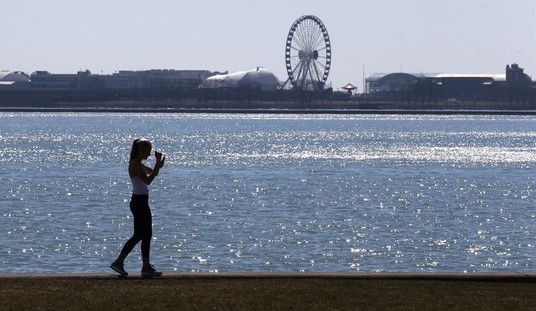As we reported early Monday, the Medical Examiner for the District of Columbia, Francisco Diaz, has informed the Washington Post — they should be the first to know, correct? — that Capitol Police Officer Brian Sicknick died from “acute brainstem and cerebellar infarcts due to acute basilar artery thrombosis.” In layman’s terms, he suffered a fatal stroke.
Dr. Diaz stated that Sicknick died on January 7 and that his death was due to “natural causes,” apparently not directly connected to anything that happened while he was on duty during the protest activity at the Capitol on January 6. Dr. Diaz noted, as our Managing Editor Jennifer Van Laar reported, that “Sicknick was among the officers who engaged the Capitol mob and said that “all that transpired played a role in his condition.”
According to the American Stroke Association website:
Brain stem strokes can have complex symptoms, and they can be difficult to diagnose. A person may have vertigo, dizziness and severe imbalance without the hallmark of most strokes — weakness on one side of the body.
Risk factors for brain stem stroke are the same as for strokes in other areas of the brain: high blood pressure, diabetes, heart disease, atrial fibrillation and smoking. Similarly, brain stem strokes can be caused by a clot or a hemorrhage.
“Thrombosis” is a clotting of the blood. “Infarction” is the blockage of a blood vessel or artery.
“Basilar artery thrombosis” is described as:
Basilar artery thrombosis is a devastating form of stroke with high morbidity and mortality. Its initial presentation is often extremely nonspecific and may include dizziness or blurring of vision.
Basilar artery occlusions are believed to account for approximately only 1% of all strokes. Basilar artery occlusion has been reported in 2 out of 1000 post-mortem cases.
So while this is a rare form of stroke — much less frequent than the more typical hemispheric stroke which happens on one side of the brain or the other — the post-mortem examination of the brain by the Medical Examiner would have identified the basilar artery and brain stem as the location of the thrombosis and infarction site.
Yet the cause of death has been hidden from the public by the Department of Justice as it went about crafting a narrative about the January 6 protests, which it continued to do after the causes of all the day’s deaths — except for Ashlii Babbit (shot by a Capitol Hill Police Officer) and Officer Brian Sicknick — were known to DOJ.
Even though his death was not directly related to the events of January 6, the Democrats who controlled the Congress opted to have Officer Sicknick’s body lie in honor at the Capitol Rotunda because his death was ostensibly caused by injuries sustained that day. The national media was right there to play its part — from NPR:
Brian Sicknick, the slain U.S. Capitol Police officer who was given the rare distinction of lying in honor in the Capitol Rotunda, received a final tribute from lawmakers Wednesday. President Biden and first lady Jill Biden joined Sicknick’s family members and colleagues from the Capitol Police in a period of visitation on Tuesday night.
Sicknick, 42, died from injuries he sustained fending off members of the mob that breached the Capitol complex on Jan. 6.
That could not be a bigger falsehood — and an untold number of DOJ officials had to have known it wasn’t true because they would have had access to the medical evidence pertaining to any victims of the January 6 protests. But NPR was far from alone:
Here is ABC News:
Members of Congress and law enforcement gathered at the Capitol Rotunda Wednesday for a ceremony to honor Capitol Police officer Brian Sicknick, who died from injuries suffered in the violent siege on the U.S. Capitol.
Here is USA Today:
WASHINGTON – Capitol Police officer Brian Sicknick, who died from injuries sustained during the Jan. 6 riot at the Capitol, was returned Tuesday evening to lie in honor in the Rotunda.
As is noted in the Washington Examiner story today, two specific individuals charged in connection with the January 6 protests are identified as having coordinated an assault on Sicknick. But those two defendants have NOT been charged in any fashion with having acted in a manner that caused Sicknick’s death:
Julian Elie Khater and George Pierre Tanios were charged in March with coordinating to assault Sicknick and two other officers with a chemical spray, although the men were not accused of murdering Sicknick and have not been charged in connection with his death.
Consider that non-charging decision against the statement in January by the Deputy Attorney General:
Former acting Attorney General Jeffrey Rosen said the day after Sicknick’s death that the officer “succumbed last night to the injuries he suffered defending the U.S. Capitol against the violent mob who stormed it.” He added that the Justice Department “will spare no resources in investigating and holding accountable those responsible.”
FBI Director Christopher Wray repeatedly declined to provide details related to the death of Sicknick during Senate testimony in March.
They never commented on Sicknick’s cause of death, and they took no prosecutorial action regarding his cause of death because they knew the ME had determined he died of natural causes.
CNN contributes to that part of the story:
Authorities have reviewed video and photographs that show Sicknick engaging with rioters amid the siege but have yet to identify a moment in which he suffered his fatal injuries, law enforcement officials familiar with the matter said.Soon after Sicknick died on January 7, prosecutors in Washington opened a federal murder investigation, dedicating a team inside the US attorney’s office to build out a case, authorities have said.
That was the correct step to take — make Sicknick’s death the subject of an immediate investigation. But what it means is that as soon as DOJ had the autopsy report and knew that Sicknick’s death wasn’t directly attributable to what happened on January 6, allowing that narrative to carry forward in the press was all part of an intentionally driven political narrative.
And there was a report on January 8 — one day after this death — that the Sicknick family was already led to believe that he had died of a stroke. That was reported here on RedState.
Everything that came after January 8 that linked Sicknick’s death to the Jan. 6 protests was all one big exercise in propaganda to demonize the Trump supporters who showed up in Washington to protest.
Again, will the press express any outrage at the fact that it was misled and used to advance a political agenda?
No — really.
Quit laughing.
I’m serious.














Join the conversation as a VIP Member